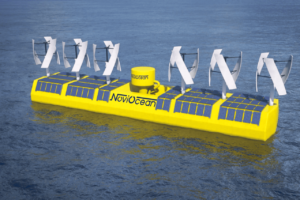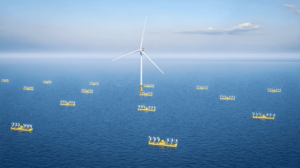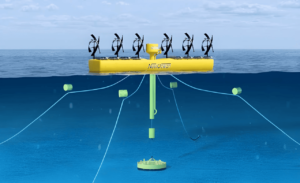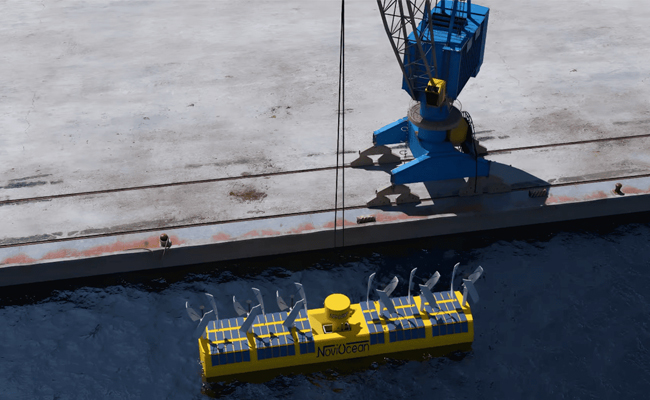Swedish company NoviOcean has tested the third-generation prototype of itsc solar, and wave energy hybrid platform. This floating platform, driven by buoyancy mechanisms, can provide up to 1 megawatt of continuous clean energy. It is now set to enter a full-scale pilot phase!

1. How Does It Work?
Once fully constructed, the renewable energy platform will have a compact footprint of 38 x 9 meters. It stands about 4 meters above the water, with a draft depth of 12 meters. Compared to large floating offshore wind turbine installations, it is significantly smaller. However, with a design weight exceeding 140 tons, it delivers a more stable energy output than any single-source generator.

When the sun shines, it powers about 700 square meters of solar panels, generating up to 50 kW. Wind energy is captured by six vertical-axis wind turbines (VAWTs). Additionally, an innovative wave energy system harvests up to 650 kW from ocean movement.
Compared to traditional floating offshore wind turbine designs with horizontal-axis turbines, vertical-axis turbines offer three key advantages. First, the generator is at the base rather than at the top of a tower, improving stability. Second, VAWTs capture wind from any direction without requiring yaw adjustments. Third, the hybrid platform is easy to build, install, and maintain. It is also visually unobtrusive and can be deployed in clusters due to VAWTs’ weaker wake effect.
2. An Innovative Wave Energy Generator
The wave energy generator operates in a unique way. The large structure extending from the top resembles a plug and houses a turbine-generator system. The top of this piston is fixed to the floating platform, while the bottom is anchored to the seabed.
As waves move, the platform floats downward. At the bottom of its stroke, a valve closes, holding it down. This forces the buoy underwater, submerging up to 3 meters and trapping about 600 cubic meters of air.

At the right moment, the valve opens, releasing buoyancy and generating up to 600 tons of lift. As the buoy rises, this force pulls water through a pipeline, accelerating it through a Pelton turbine at the top. This process produces up to 650 kW of instantaneous clean energy. NoviOcean states that only 4-meter-high waves are needed to reach peak output.

3. Project Progress
NoviOcean claims that a full-scale platform can operate 24/7 at a capacity factor of 40-70%. It generates an average of 3.5 GWh per year, enough to power about 324 households.
The company has built three prototypes at scales of 1/7, 1/6, and 1/5. The latest has undergone 24 months of bench testing, 6 weeks in a wave pool, and 14 months offshore. NoviOcean reports that real-world performance matches simulation predictions.
The next step is a full-scale pilot platform, planned for construction and deployment by 2026-2027. A “pre-commercial array” is expected between 2028-2030, with full commercial deployment by 2031-2032.
4. What About the Cost?
All renewable energy solutions are judged by their Levelized Cost of Energy (LCoE). This metric assesses the cost of producing electricity over a project’s lifetime, covering construction, installation, maintenance, labor, and decommissioning.
NoviOcean estimates that its first full-size 1-MW hybrid floating offshore wind turbine platform will cost €3.6 million ($4 million). However, economies of scale could reduce the cost of its 100th platform to €2 million ($2.2 million). The initial LCoE is projected at $275/MWh, about one-third of early wind and solar projects but still higher than current levels.
LCoE alone may not tell the full story. With multiple energy sources, the platform may sell power at peak prices when other renewables cannot contribute. However, without government support, it may struggle to compete at first. NoviOcean is currently seeking private investors.
Financial concerns are not the only challenge. Hydraulic pistons must operate in seawater for decades, but marine corrosion remains a major issue.
The world needs to expand renewable energy significantly in the coming decades. This is not only to replace current energy use but also to support the electrification of transportation, large-scale cryptocurrency mining, and AI advancements. A diversified clean energy grid is essential to ensure reliability, even when sunlight and wind are scarce.



